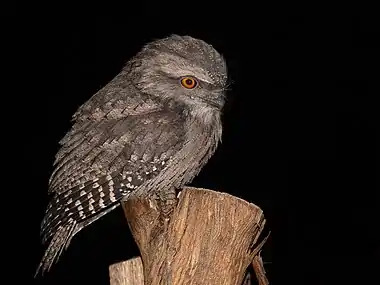| Frogmouths | |
|---|---|
 | |
| Tawny frogmouth, at night | |
| Scientific classification | |
| Domain: | Eukaryota |
| Kingdom: | Animalia |
| Phylum: | Chordata |
| Class: | Aves |
| Clade: | Strisores |
| Clade: | Vanescaves |
| Order: | Podargiformes Matthews, 1918 |
| Family: | Podargidae Gray, 1847 |
| Genera | |
The frogmouths (Podargidae) are a group of nocturnal birds related to owlet-nightjars, swifts, and hummingbirds. Species in the group are distributed in the Indomalayan and Australasian realms.
Biology
They are named for their large flattened hooked bill and huge frog-like gape, which they use to capture insects. The three Podargus species are large frogmouths restricted to Australia and New Guinea, that have massive flat broad bills. They are known to take larger prey, such as small vertebrates (frogs, mice, etc.), which are sometimes beaten against a stone before swallowing.[1] The ten Batrachostomus frogmouths are found in tropical Asia. They have smaller, more rounded bills and are predominantly insectivorous. Both Podargus and Batrachostomus have bristles around the base of the bill, and Batrachostomus has other, longer bristles which may exist to protect the eyes from insect prey.[1] In April 2007, a new species of frogmouth was described from the Solomon Islands and placed in a newly established genus, Rigidipenna.[2]
Their flight is weak. They rest horizontally on branches during the day, camouflaged by their cryptic plumage. Through convergent evolution as night hunters, they resemble owls, with large front-facing eyes.
Up to three white eggs are laid in the fork of a branch, and are incubated by the female at night and the male in the day.
Taxonomy
DNA-DNA hybridisation studies had suggested that the two frogmouth groups may not be as closely related as previously thought, and that the Asian species may be separable as a new family, the Batrachostomidae.[3][4] Although frogmouths were formerly included in the order Caprimulgiformes, a 2019 study estimated the divergence between Podargus and Batrachostomus to between 30 and 50 mya and forming a clade well separated from the nightjars and being a sister group of the swifts, hummingbirds, and owlet-nightjars. The name Podargiformes proposed in 1918 by Gregory Mathews was reinstated for the clade.[5]
Species

- Genus Podargus
- Tawny frogmouth, Podargus strigoides
- Marbled frogmouth, Podargus ocellatus
- Papuan frogmouth, Podargus papuensis
- Genus Batrachostomus
- Large frogmouth, Batrachostomus auritus
- Dulit frogmouth, Batrachostomus harterti
- Philippine frogmouth, Batrachostomus septimus
- Gould's frogmouth, Batrachostomus stellatus
- Sri Lanka frogmouth, Batrachostomus moniliger
- Hodgson's frogmouth, Batrachostomus hodgsoni
- Sumatran frogmouth, Batrachostomus poliolophus
- Javan frogmouth, Batrachostomus javensis
- Blyth's frogmouth, Batrachostomus affinis
- Sunda frogmouth, Batrachostomus cornutus
- Palawan frogmouth, Batrachostomus chaseni
- Bornean frogmouth, Batrachostomus mixtus
- Genus Rigidipenna
- Solomons frogmouth, Rigidipenna inexpectata
In culture
In a journal article published in April 2021, researchers Katja Thömmes and Gregor Hayn-Leichsenring from the Experimental Aesthetics group at the University Hospital Jena, Germany, found the frogmouth to be the most "instagrammable" bird species.[6] Using an algorithm to analyze the aesthetic appeal of more than 27,000 bird photographs on Instagram, they found that photos depicting frogmouths received the highest number of likes relative to the posts' exposure to users. The journal article was picked up by several news outlets, including The New York Times and The Guardian.[7]
References
- 1 2 Perrins, Christopher (2003). Firefly Encyclopedia of Birds. Firefly Books. p. 342. ISBN 1-55297-777-3.
- ↑ Cleere; et al. (2007). "A new genus of frogmouth (Podargidae) from the Solomon Islands – results from a taxonomic review of Podargus ocellatus inexpectatus Hartert 1901". Ibis. 149 (2): 271–286. doi:10.1111/j.1474-919x.2006.00626.x.
- ↑ Sibley, Charles G.; Alquist, John E.; Monroe Jr., Burt L. (July 1988). "A Classification of the Living Birds of the World Based on Dna-Dna Hybridization Studies" (PDF). The Auk. 105 (3): 409–423. doi:10.1093/auk/105.3.409. JSTOR 4087435.
- ↑ Mayr, G (2002). "Osteological evidence for paraphyly of the avian order Caprimulgiformes (nightjars and allies)" (PDF). Journal für Ornithologie. 143 (1): 82–97. doi:10.1007/bf02465461. ISSN 0021-8375. S2CID 42119957.
- ↑ Chen, Albert; White, Noor D.; Benson, Roger B.J.; Braun, Michael J.; Field, Daniel J. (2019). "Total-Evidence Framework Reveals Complex Morphological Evolution in Nightbirds (Strisores)". Diversity. 11 (9): 143. doi:10.3390/d11090143.
- ↑ Thömmes, Katja; Hayn-Leichsenring, Gregor (2021-03-01). "What Instagram Can Teach Us About Bird Photography: The Most Photogenic Bird and Color Preferences". i-Perception. 12 (2): 20416695211003585. doi:10.1177/20416695211003585. ISSN 2041-6695. PMC 8073730. PMID 33996019.
- ↑ Waller, Allyson (2021-04-29). "This 'Angry' Bird Is the Most Photogenic, Research Finds". The New York Times. ISSN 0362-4331. Retrieved 2021-04-30.
External links
- Frogmouth videos on the Internet Bird Collection
- Video: Finding the Sri-Lanka Frogmouth, Southern India
- Scientists discover new genus of frogmouth bird in Solomon Islands